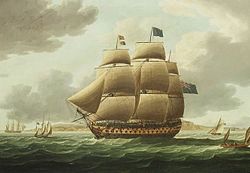HMS Ville de Paris

The Ship Ville de Paris under Full Sail, a painting of Thomas Buttersworth
|
|
| History | |
|---|---|
|
|
|
| Name: | HMS Ville de Paris |
| Ordered: | 25 May 1788 |
| Builder: | Chatham Dockyard |
| Laid down: | 1 July 1789 |
| Launched: | 17 July 1795 |
| Fate: | Broken up, 1845 |
| General characteristics | |
| Class and type: | 110-gun first rate ship of the line |
| Tons burthen: | 2351 (bm) |
| Length: | 190 ft (58 m) (gundeck) |
| Beam: | 53 ft (16 m) |
| Depth of hold: | 22 ft 4 in (6.81 m) |
| Propulsion: | Sails |
| Sail plan: | Full rigged ship |
| Armament: | |
HMS Ville de Paris was a 110-gun first rate ship of the line of the Royal Navy, launched on 17 July 1795 at Chatham Dockyard. She was designed by Sir John Henslow, and was the only ship built to her draught. She was named after the French ship of the line Ville de Paris, flagship of François Joseph Paul de Grasse during the American Revolutionary War. That ship had been captured by the Royal Navy at the Battle of the Saintes in April 1782, but on the voyage to England, as a prize, she sank in a hurricane in September 1782.
She served as the flagship of John Jervis, 1st Earl of St Vincent, with the Channel Fleet.
On 17 August 1803, the boats of Ville de Paris captured the French privateer Messager from among the rocks off Ushant. Lloyd's Patriotic Fund awarded Lieutenant Watts, of Ville de Paris, with an honour sword worth £50 for his role in the cutting out expedition. Messager was pierced for eight guns but had six mounted, and had her owner and 40 men aboard when Watts arrived with his pinnace and 18 men. The British captured her before the other boats from Ville de Paris could arrive. The French put up a minimal resistance and only suffered a few men lightly wounded; the British suffered no casualties. The action occurred in sight of the hired armed cutter Nimrod. In January 1805 head and prize money from the proceeds of the French privateer Messager was due to be paid.
...
Wikipedia
